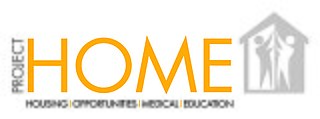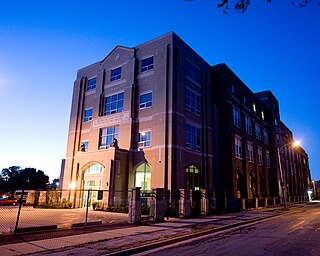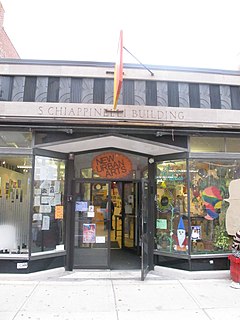Related Research Articles

Homelessness in the United States refers to the issue of homelessness, a condition wherein people lack "a fixed, regular, and adequate nighttime residence" as defined by The McKinney–Vento Homeless Assistance Act. Point-in-time single night counts prepared by shelter providers differ greatly from federal government accounts. In 2014, approximately 1.5 million sheltered homeless people were counted. The federal government statistics are prepared by the United States Department of Housing and Urban Development's Annual Homeless Assessment Report; as of 2018, HUD reported there were roughly 553,000 homeless people in the United States on a given night, or 0.17% of the population. Annual federal HUD reports contradict private state and local reports where homelessness is shown to have increased each year since 201 across several major American cities, with 40 percent increases noted in 2017 and in 2019. In January of 2018 the federal government statistics gave comprehensive encompassing nationwide statistics, with a total number of 552,830 individuals, of which 358,363 (65%) were sheltered in provided housing, while some 194,467 (35%) were unsheltered.

Homeless shelters are a type of homeless service agency which provide temporary residence for homeless individuals and families. Shelters exist to provide residents with safety and protection from exposure to the weather while simultaneously reducing the environmental impact on the community. They are similar to, but distinguishable from, various types of emergency shelters, which are typically operated for specific circumstances and populations—fleeing natural disasters or abusive social circumstances. Extreme weather conditions create problems similar to disaster management scenarios, and are handled with warming centers, which typically operate for short durations during adverse weather.
The Arab Community Center for Economic and Social Services (ACCESS) is a human services organization committed to the development of the Arab American community. ACCESS helps low-income families, as well as newly arrived immigrants adapt to life in the United States. Its goal is to foster a greater understanding of Arab culture in the U.S. and in the Arab world. ACCESS provides social, mental health, educational, artistic, employment, legal, and medical services.
Princeton AlumniCorps is an American nonprofit organization established in 1989 as Princeton Project 55. Members of the Class of 1955 at Princeton University established the organization to mobilize alumni and students, and others who share their concerns, to provide civic leadership and to develop and implement solutions to systemic problems that affect the public interest. Princeton AlumniCorps is an independent nonprofit 501(c)(3) organization.
Supporting Our Youth (SOY) is an organization based in Toronto, Ontario, Canada, which runs programs and events geared to supporting the special needs of gay, lesbian, bisexual, transgender, transsexual and intersex youth. SOY gets support and involvement from local youth and adults that volunteer their time to help improve each other’s lives. SOY’s main focus points are helping the youth create healthy arts, recreational spaces, culture, supportive housing, and employment.
Xtus Society (Socio-Civic Youth Organization based on Province of Bukidnon.
Hamilton-Madison House is a voluntary, non-profit settlement house dedicated to improving the quality of life of its community, primarily that of the Two Bridges/Chinatown area of the Lower East Side of Manhattan, New York City, United States. The neighborhood is a federally designated poverty area, with a constantly changing mixture of ethnic groups, and lack of adequate services and resources. An average income of a family living in the area is $17,000. Further, more than 25% of the seniors live on less than $15,000 a year, of which 40% goes toward housing. In the past 108 years, Hamilton-Madison House has developed programs that meet the changing needs of its community. In 1965, with a change in federal immigration policies, the community's predominant immigrant became Chinese New Yorkers. Since that time, the organization's staff has grown to include a staff of 300 who collectively speak 15 languages, including 6 Chinese dialects. Further, the House's long-standing programs have been adapted to meet the cultural norms of this expanding population.
After-school activities, also known as after-school programs or after-school care, started in the early 1900s mainly just as supervision of students after the final school bell. Today, after-school programs do much more. There is a focus on helping students with school work but can be beneficial to students in other ways. An after-school program, today, will not limit its focus on academics but with a holistic sense of helping the student population. An after-school activity is any organized program that youth or adult learner voluntary can participate in outside of the traditional school day. Some programs are run by a primary or secondary school, while others are run by externally funded non-profit or commercial organizations. After-school youth programs can occur inside a school building or elsewhere in the community, for instance at a community center, church, library, or park. After-school activities are a cornerstone of concerted cultivation, which is a style of parenting that emphasizes children gaining leadership experience and social skills through participating in organized activities. Such children are believed by proponents to be more successful in later life, while others consider too many activities to indicate overparenting. While some research has shown that structured after-school programs can lead to better test scores, improved homework completion, and higher grades, further research has questioned the effectiveness of after-school programs at improving youth outcomes such as externalizing behavior and school attendance. Additionally, certain activities or programs have made strides in closing the achievement gap, or the gap in academic performance between white students and students of color as measured by standardized tests. Though the existence of after-school activities is relatively universal, different countries implement after-school activities differently, causing after-school activities to vary on a global scale.

Thread is a 501(c)(3) non-profit organization that was founded by Sarah and Ryan Hemminger as a partnership between students at Johns Hopkins University and two Baltimore City High Schools: Paul Laurence Dunbar High School and the Academy for College and Career Exploration. The goal of Thread is to transform teenagers who are failing high school into Baltimore City's most valuable role models. Thread extends a school-based tutoring program to the home, providing both academic and social support to youth struggling with poverty, drugs, and violence. Mentoring teams, called "Thread Families" not only support teenagers in overcoming their own adversity, but also encourage them to help others do the same. The first group of Thread students achieved a 100% graduation and 100% college enrollment rate.
St. James ESL Program, est. 1975, is a community-based volunteer literacy organization in Seattle, Washington, United States. St. James ESL provides free ESL instruction and naturalization assistance to low-income adult immigrants and refugees in King County. This community outreach service of St. James Cathedral is non-sectarian: there are no requirements regarding religious affiliation for staff, volunteers, or students.

Homelessness is lacking stable and appropriate housing. People can be categorized as homeless if they are: living on the streets ; moving between temporary shelters, including houses of friends, family and emergency accommodation ; living in private boarding houses without a private bathroom or security of tenure. The legal definition of homeless varies from country to country, or among different jurisdictions in the same country or region. United States government homeless enumeration studies also include people who sleep in a public or private place not designed for use as a regular sleeping accommodation for human beings. People who are homeless are most often unable to acquire and maintain regular, safe, secure and adequate housing due to income that is inconsistent or lacking altogether. Homelessness and poverty are interrelated. There is no methodological consensus on counting the homeless and identifying their needs; therefore in most cities only estimated homeless populations are known.
buildOn is an international nonprofit organization that runs youth service afterschool programs in United States high schools and builds schools in developing countries. The organization's programs engage young Americans from mostly urban areas in community service and promote literacy among children and adults in developing countries.

Project HOME is a nationally recognized 501(c)(3) non-profit organization that provides housing, opportunities for employment, medical care and education to homeless and low-income persons in Philadelphia, Pennsylvania.

The Milwaukee Rescue Mission is a shelter for homeless and ailing families. Since 1893, it has worked with the hungry and hurting of Milwaukee, helping them restore their lives and their hope. In its Milwaukee home, any given night will see nearly 1,500 homeless people will be on the streets. The Milwaukee Rescue Mission seeks to meet those in need where they are. The Milwaukee Rescue Mission offers practical assistance like food, clothing, and shelter. In addition, the shelter offers transformative programs that equip struggling men, women, and children to get off the streets and turn their lives around for good. While practical assistance is important, the Milwaukee Rescue Mission supplies both short- and long-term assistance, complemented by education, counseling, help in overcoming substance abuse, job training and much more. The organization bases its programs on addressing the root causes of problems, rather than simple temporary fixes. As a non-denominational Christian organization, it provides spiritual development and enrichment, all based on the good news of the Gospel; it professes that the Gospel message is the key to lasting change. The Milwaukee Rescue Mission is part of the Association of Gospel Rescue Missions.

Lessie Bates Davis Neighborhood house is a 103-year-old comprehensive social services organization based in East St. Louis, Illinois. It is a United Way organization and is a United Methodist settlement house operating 22 programs at five sites in the Metro East St. Louis Metro East.

Kingsbridge Heights Community Center (KHCC) is a settlement house founded in 1974 by community activists Janet Athanasidy, Patricia Burns, and Mary McLoughlin, serving the Kingsbridge Heights neighborhood and the Bronx. KHCC offers programs and services in multiple sites for more than 4,500 people annually. Guided by the settlement house model of community development and involvement, KHCC is a member of United Neighborhood Houses of New York City. KHCC’s mission is to “empower Bronx residents from cradle to career to advance education and well-being for a vibrant community. ”
Sports-Based Youth Development or SBYD is a theory and practice model for direct youth service. Grounded in youth development, sports psychology, and youth sports practice, SBYD aims to use the sport experience to contribute to positive youth development. Sports-based youth development is similar to sport for social development.

New Urban Arts is a nonprofit arts organization that provides after school arts mentoring and studio space for high school students and emerging artists in Providence, Rhode Island. In 2017, students at New Urban Arts came primarily from four Providence schools: Classical High School, Central High School, the Metropolitan Regional Career and Technical Center, and Providence Career and Technical Academy. The organization focuses on helping students develop a life-long creative practice, a summer arts inquiry program, and a leadership program that allows student participants to drive the direction of the organization. Each year, New Urban Arts serves 700 high school students, 25 emerging artists, and 2,000 visitors to the studio.

Edgar Gonzalez, Jr. is a Democratic member of the Illinois House of Representatives for the 21st District. The 21st District includes all or parts of the Chicago neighborhoods of Archer Heights, Brighton Park, Garfield Ridge, McKinley Park, South Lawndale and the Lower West Side along with the nearby suburbs of Stickney, Forest View, Lyons, Riverside, Summit and Bedford Park.
References
- ↑ Phillips Brooks House Association Harvard Yard. "Programs" . Retrieved 27 May 2020.
- ↑ Seider, Scott (2010). Shelter: where Harvard meets the homeless. New York: Continuum. p. 293.